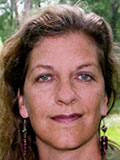Lafayette, collaborators shaping creativity institute at Texas A&M

Carol LaFayette
An institute promoting the study and application of creativity and innovative thinking across colleges and disciplines at Texas A&M and throughout a network of academic, corporate, community, and nonprofit partners is under development at the College of Architecture.
“The [Institute of Applied Creativity] (http://creativity.tamu.edu/) is interested in developing context-specific methodologies of creativity, meaning it's not ‘one size fits all,’ by establishing communication and collaboration opportunities between groups traditionally operating in separate arenas,” said institute director Carol LaFayette.
“Look out on the landscape of this campus,” she said. “Like many research institutions, it houses silos of really deep and valuable knowledge resources on specific and important subjects. This institute could be included in the picture, throwing ropes across these silos to make surprising connections in order to address some of today’s most pressing problems.”
LaFayette is developing institute initiatives in consultation with Jorge Vanegas, dean of the College of Architecture, and Rodney Hill, professor of architecture. Vanegas and Hill lead the college’s [Design Process] (http://archone.tamu.edu/college/news/newsletters/fall2009/stories/Rodney_design.html) class, which places a premium on creativity and entrepreneurial innovation.
Collaborators also include Franz Ehrhardt, who heads [CASCA Consulting] (http://www.cascaconsulting.com) , a business working with clients on solving problems through innovative strategy formulation and implementation, and Bill Peel ‘74, an executive with [Tellepsen] (http://www.tellepsen.com) , a Houston-based leader in commercial and industrial construction. Peel earned master and bachelor of architecture degrees at Texas A&M.
In addition to bringing diverse groups together, LaFayette said the center is also building knowledge resources through aggregating information.
“Today, there is a wealth of accessible information on creative strategies, and on organizations asking questions about the road to innovation,” she said. “The institute is building a database of resources for academia, business, and diverse communities to facilitate its role as matchmaker of sorts, to foster productive connections.”
“For instance,” she said, “if one domain has a solution for an innovative, economically productive idea, the institute could serve as a conduit so that another domain could adapt usable aspects of this idea — a form of technology and knowledge transfer.”
She said the institute is also collecting information on interdisciplinary and creative coursework on campus and outside of campus so coursework at Texas A&M can be informed by best practices.
LaFayette said the institute is also forming different types of creativity seminars for groups.
One type of seminar, for example, would cater to businesses with the resources to enhance energy efficiency looking for creative ways to move beyond established methods of thinking in order to incorporate sustainable initiatives.
Another seminar will host an interdisciplinary team of academic researchers from Texas collaborating with researchers at NASA to develop a middle school curriculum that includes the arts, blended with science, technology, engineering and math — a “ [STEAM] (http://one.arch.tamu.edu/news/2011/8/4/lafayette-nsf/) ” curriculum.
The institute will also benefit community arts initiatives by helping match student expertise with professional opportunities for engagement. In the Memorial Student Center’s Forsyth Galleries early next year, the institute will facilitate a student-designed exhibition celebrating 40 years of Texas A&M’s [OPAS] (http://opas.tamu.edu) events, a series of theater, music and dance performances.
The center could also, said LaFayette, place an emphasis on invention entrepreneurship, recruiting students to the university to collaborate in creating the university’s future.
“Imagine students getting involved in creating new courses, so they can invent their own future careers?” asked LaFayette. “What would that be like?”
Previous post
Tags
- academics
- applied creativity
- building a better texas
- entrepreneurship
- feature
- interdisciplinary
- outreach
- partnerships
- research
- rss
- sustainability
- technology
Related Posts
NSF group melding art, science learning

Initiative fusing arts, technology education gains momentum

Micro-manufacturing initiative earns NSF Convergence Award

Green roof growing atop Langford A
Follow Us
Facebook Twitter Vimeo Youtube Flickr RSS
Recent Posts

Planning prof heads study of disaster housing aid

A message from the dean

Former student remembered as expert planner

Leading educator named new head of Architecture Dept.






_thumbnail_small.png)
